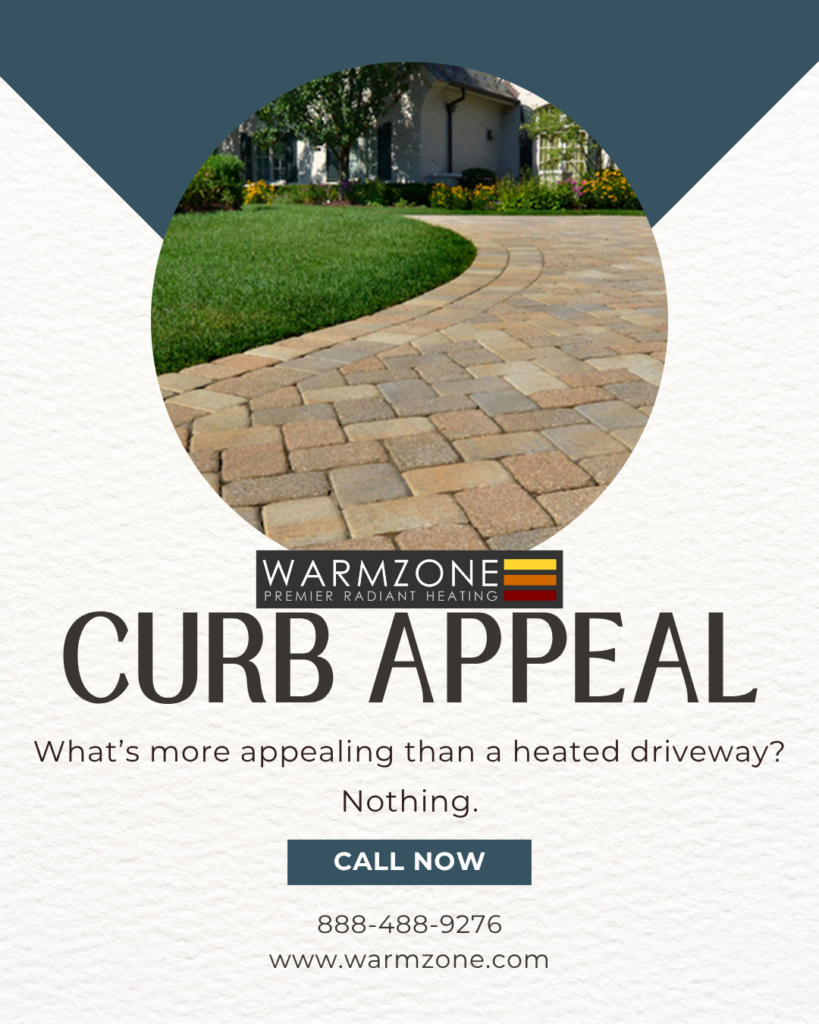
Curb Appeal. Winter Ready.



Learn more about Warmzone’s selection of premium floor warming systems. Contact Warmzone today.
As spring fully settles in and the last traces of snow vanish, we’re shifting from snow shovels to summer plans. But savvy homeowners know that now, not fall, is the smartest time to prepare for next winter. Why? While the snow may be melting, demand for radiant-heated driveway systems is heating up.
Installing a snow-melting system isn’t just a luxury—it’s a wise investment in safety, comfort, and convenience. And while the cold months might feel far off, the truth is the best time to plan for them is now.
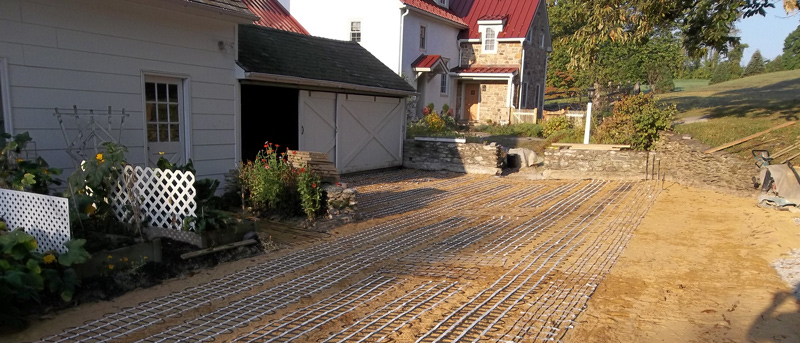
Snowmelt doesn’t just clear your driveway—it reveals the wear and tear left behind from a long winter. As you start thinking about replacing, resurfacing, or repairing concrete or asphalt, it’s the perfect moment to consider integrating a radiant heating system beneath the surface.
Spring and early summer offer optimal conditions for installation. With the ground thawed and construction schedules still relatively open, this is the ideal window to get everything in place without the last-minute stress.
Another perk of planning your installation in May or June? You’ll have more time to customize the system layout to suit your home and how you use your driveway. Our experts can help you map out heat zones—targeting high-traffic areas, sloped sections, or just the tire lanes—to balance performance and cost.
We’ll also work with your installer to ensure:
As we head into peak construction season, we already see signs of increased demand and longer lead times. With material costs fluctuating and supply chains tightening, acting now means locking in current pricing and getting ahead of potential increases down the line.
Don’t wait until fall when everyone else is scrambling. Scheduling your radiant heated driveway system now ensures smoother installation, better availability, and potentially lower overall costs.
Whether you’re resurfacing or starting fresh, Warmzone offers ClearZone™ heated driveway systems that integrate seamlessly with:
These systems are customizable, energy-efficient, and built to last—trusted by homeowners and commercial property owners.
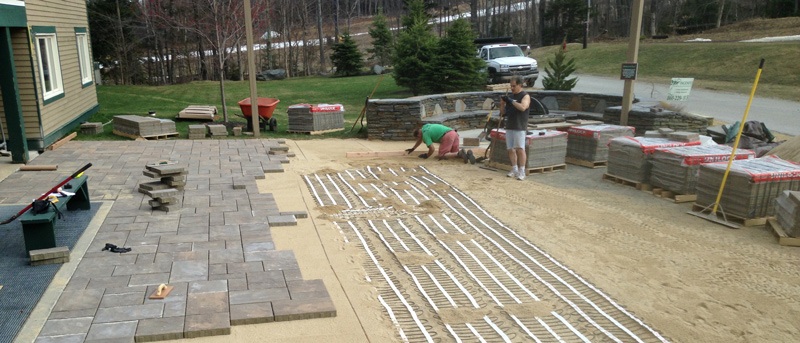
A radiant heated driveway is more than just a seasonal upgrade—it’s a long-term improvement that enhances your property’s value, reduces maintenance, and provides peace of mind during winter storms.
So, while the snow may be behind us for now, May is the time to plan ahead. Secure your installation slot, avoid seasonal price hikes, and make next winter the easiest one yet.
Call 888-488-9276 to speak with a Warmzone specialist. We’ll walk you through your best options based on your surface, layout, and goals—and help you schedule an installation that sets your system (and your driveway) up for long-term success.
Because when it comes to winter prep, doing it right starts right now.

Learn more about Warmzone’s vast selection of premium floor warming systems. Contact Warmzone today.
Life comes with many challenges, but technology continues to whittle down the hardships to counter the difficulties we face every day. Granted, some of us wonder whether technology adds to our stress, or alleviates it, but one thing most home and business owners agree on is that the technology behind radiant heat systems has made things a whole lot easier and more comfortable for us.
One of the most popular applications of radiant heat is that of heating driveways. Given that radiant heat is the most energy-efficient heating technology available today, radiant snow melting systems are a popular choice for keeping driveways, sidewalks, ramps, outdoor steps, and more, clear of snow and ice during the winter months. Radiant heat is also used for roof de-icing applications. Self-regulating heat cable is used to prevent ice dams and to keep roof gutters and downspouts free from heavy snow and ice.
In addition to efficiently operating on renewable energy, Warmzone driveway heating and snow melting systems are fully automated. Once installed, the homeowner can kick back and enjoy a morning coffee as the driveway defies the onslaught of snow that is blanketing the rest of the neighborhood. There will be no need for gloves, salt, or shovels today!
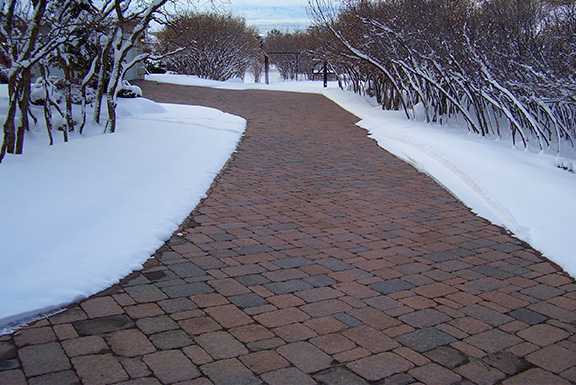
In addition to the unbeatable efficiency of radiant snow melting systems, electric heated driveways are also fully automated and maintenance free. Automated snow melting systems utilize advanced snow sensors that detect precipitation as well as temperature. When the temperature is below the adjustable set point (usually set at 39°F), and precipitation is detected, the sensor (activation device) sends a signal to the system’s controller (or contactor panel). Upon receiving the signal, the panel then sends power to the heating element that is embedded in the driveway or sidewalk. The surface area quickly begins to warm, thus preventing the snow from building up.
The efficiency and effectiveness of these radiant heat systems is due largely to the advanced system components and heating element. Both aerial-mount and pavement-mount sensors are available. Warmzone also offers contactor panels that are with or without GFEP. The panels are designed for both electric and hydronic snow melting systems, with a variety available for all types of commercial and residential applications.
Another key component of Warmzone’s radiant snow melting systems is ClearZone™ heat resistance cable. The twin-conductor cable is cCSAus listed, and available in various lengths off the spool, as well as in mats that can be rolled out for quick and easy installation. The proven cable provides easy customization, and is effective for heating concrete, asphalt, and paver driveways. The versatile snow melting systems can be installed to heat virtually any outdoor areas, ranging from steps and ramps to walkways and driveways.
Snow melting systems are also commonly used for a variety of roof de-icing applications. A variety of systems is available, most of which utilize self-regulating heat cable. The heat cable can be installed individually, or placed in aluminum panel, which are installed on the roof eaves or roof valleys. The individual cable is “zigzagged” along the roof eave to prevent ice dams from forming by providing channels for the runoff.
Complementing all of Warmzone’s premier radiant heat products are Warmzone’s unparalleled customer support services. Each snow melting system includes free installation training. The valuable training is available online and can usually be completed in less than an hour. An instructor thoughtfully covers all aspects of the installation, and answers any questions the installer(s) may have. Videos and photos of installation procedures are provided as well.
Additionally, complete system design services are provided. Each system is carefully laid out, and the design includes the placement of all the system components as well as all of the pertinent electrical information, including the proper layout and materials of the system, proper load calculations, breaker sizes, number of breakers, and so on. Electricians and installers will have all the necessary information at their fingertips.
Warmzone also includes free technical support for installers during the installation. Despite the comprehensive training and installation videos, at times, installers may encounter unforeseen issues during an installation. If there are any questions, the installer or electrician can call a Warmzone expert for assistance. Warmzone is committed to providing the best service in the industry, so installers can proceed with confidence, knowing that a team of experts is standing beside them throughout the installation.
Warmzone snow melting systems can be easily customized to meet your specific snow melting needs, power demands, and budget. Warmzone system designers create the ideal system for your home or business. When you work with Warmzone, you can be assured that you are receiving premium system components and expert, custom design and support. To learn more about these industry-leading radiant heat systems, call a friendly Warmzone representative today, at 888-488-9276.
Warmzone is one of the largest providers of custom snow melting, floor heating, and roof de-icing solutions. Warmzone also offers a wide variety of luxury home heating amenities. For more information about Warmzone radiant heat systems or luxury amenities, contact a friendly Warmzone representative today, at 888-488-9276.
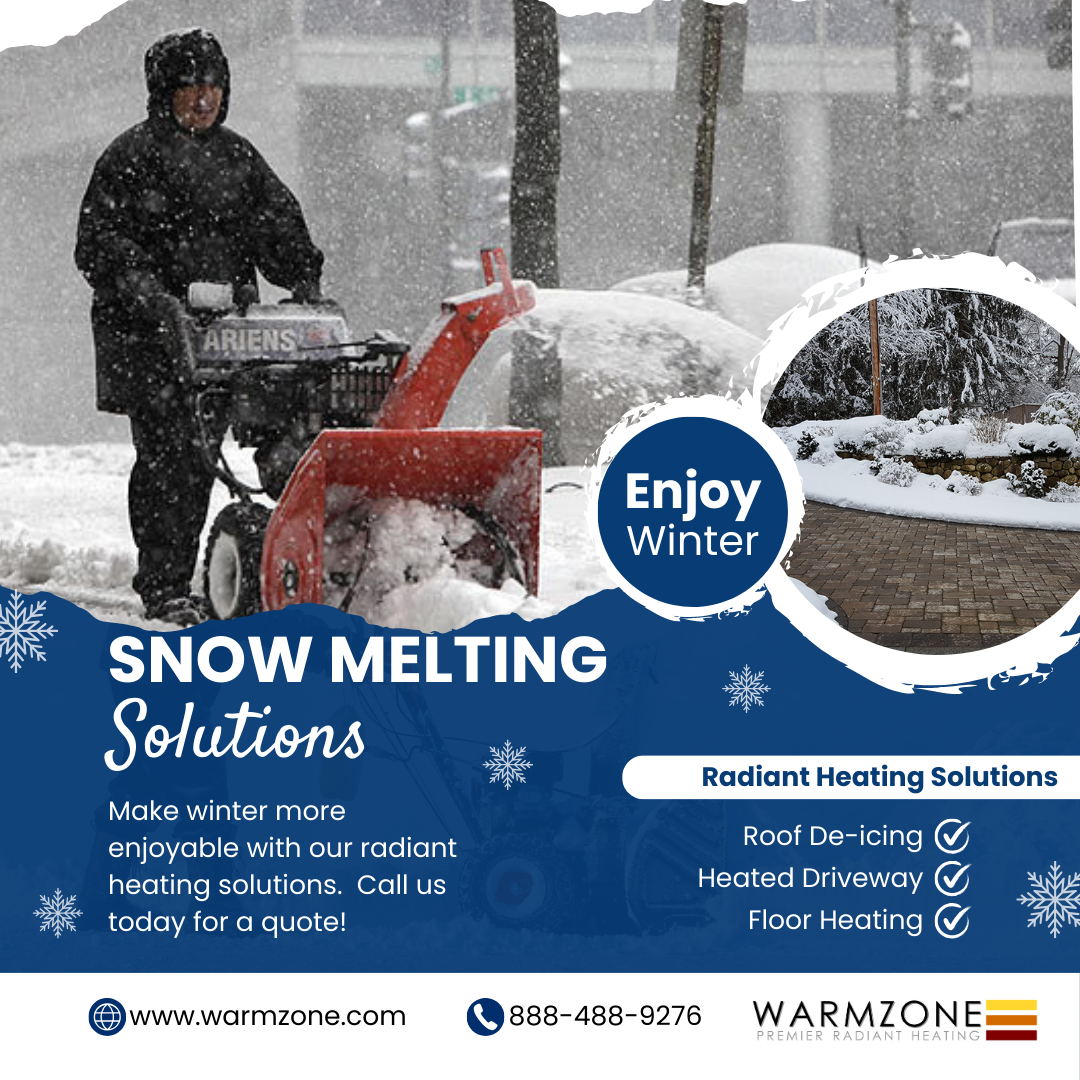
Learn more about the many radiant heat options that are available. Contact Warmzone today.
Preparing for, and Coping with Winter
Alas, another fall season is upon us. With summer having bid adieu, we can’t help but wonder what winter has in store for us this year. In anticipation of the changing weather, many of us head to the store to stock up on rock salt, snow shovels, and other items to prepare for the cold season.
It’s true that there are many of us who look forward to the winter months, excited by the reemergence of activities such as skiing, snowboarding, ice skating, and so forth. But I confess that I am no longer one of those winter sports enthusiasts. I’m afraid that those days are behind me. My winter “sporting activities” now include snow shoveling, salting, and occasional downhill skiing (without skis), immediately followed by impromptu luge runs (minus the luge) down my sloping driveway.
Yes, these “senior games” can be quite exhilarating, but not very sustainable. I think it’s time to retire these activities and adopt a safer alternative. My idea of a safer alternative is to install a radiant heated driveway.
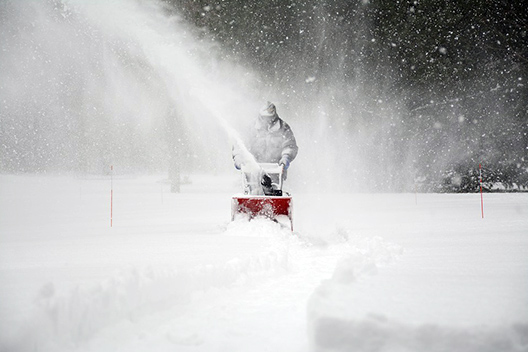
My neighbor, who has never been a winter sports enthusiast, installed a heated driveway a couple of years ago. Now, he can hardly wait for the first heavy snowfall of the season. And I get the distinct impression that he revels in watching his neighbors shovel snow from their driveways while he sits in his La-Z-Boy recliner, sipping hot chocolate. I guess I can’t really say that I blame him though.
But, without question, installing an automated radiant heated driveway is the ultimate “game ender” of my typical winter activities. Fortunately, there is still time to install a snow melting system before the winter hits.
The process is not all that complicated, especially if you deal with a seasoned professional like Warmzone. Warmzone offers electric and hydronic snow melting systems. Both will do the job, but I personally prefer the electric systems. I know that the electric snow melting systems are a lot cheaper to install, and from what I’ve seen, the performance of these systems can’t be beat.
Electric systems use durable ClearZone resistance heat cable that is available in individual lengths off the spool, or in mats that can be rolled out for quick, easy installation. The mats feature pre-spaced heat cable, so it makes installation a snap. ClearZone heat cable is a proven industry leader that is often installed to heat driveways, sidewalks, steps, ramps, loading docks, and more.
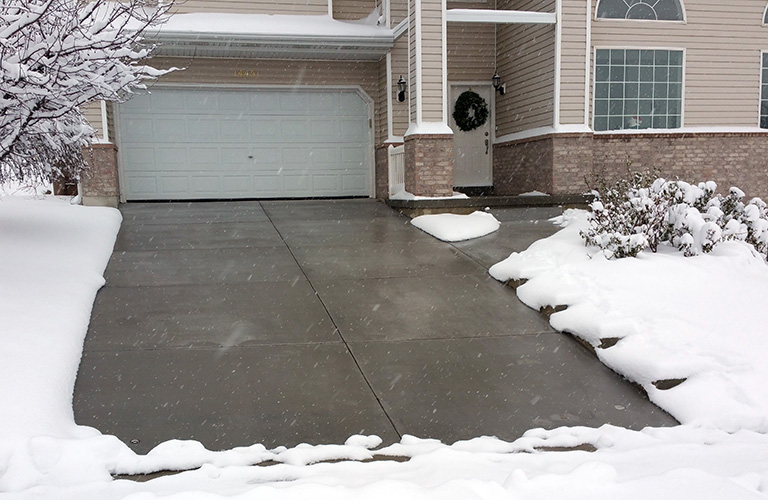
Radiant heat systems can be installed in concrete, under brick or stone pavers, and there is even a special ClearZone heating cable for hot asphalt installations. The cable is rated for a temperature of 464°F (240°C) for up to 10 minutes.
As my neighbor has reminded me (several times), radiant heated driveways are maintenance free and fully automated. Ya gotta love that. Another attractive feature is that the systems are very customizable. They can be designed to fit your precise layout needs, as well as your budget. Having lots of options to choose from makes installing a heated driveway a very real possibility for me.
Heat cable can be installed wherever you need. While many homeowners opt to heat their whole driveway, others choose to heat specific areas, with one of the most popular options being to install heated tire tracks. Others may prefer heating an 8-foot strip in the middle of the driveway. The systems can be designed to accommodate any need – and budget – of the customer.
As mentioned, electric radiant snow melting systems are maintenance free and fully automated. A high-tech sensor detects temperature and precipitation, so when the snow starts to fall, the system immediately kicks on and the driveway begins to warm. This prevents snow from building up. At the end of the storm, the heated driveway remains on for a short time to dry the surface. This eliminates the chances of thin sheets of “black ice” forming. That way the driveway is clear and dry, making it safe for vehicles and pedestrians.
If you’re considering adding a heated driveway or sidewalk or steps, give Warmzone a call. Their professionals will explain all the options and answer any questions you may have. Call today to learn more, 888-488-9276.

Contact Warmzone today.

Contact Warmzone today.
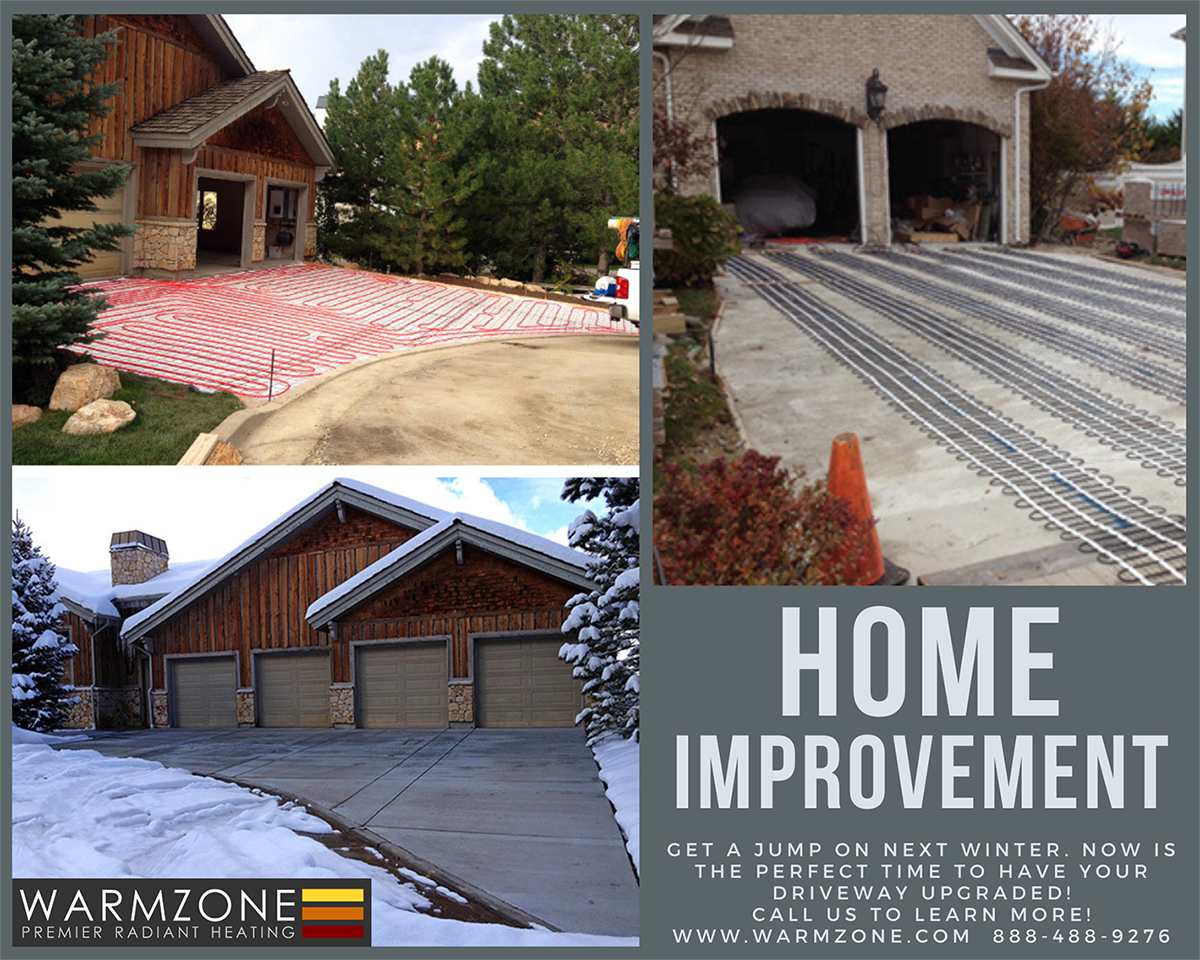
Contact Warmzone today.